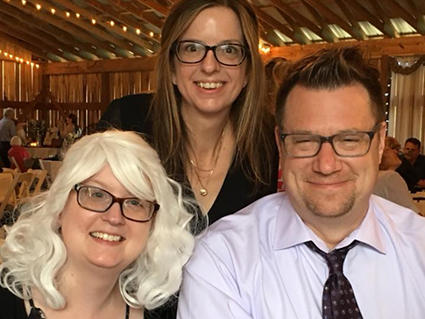Understanding the Unique Barriers Adolescents and Young Adults with Central Nervous System Cancers Face in Clinical Care
, by Raleigh McElvery, Neuro-Oncology Branch Scientific Communications Editor
In a new systematic review, researchers identify the specific challenges that make it difficult for this patient population to enroll in clinical trials and seek specialized treatment.
Each year in the United States, roughly 5,000 adolescents (age 15-19 years) and 80,000 young adults (age 20-39 years) are diagnosed with cancer. Tumors of the brain and spine, also called central nervous system (CNS) tumors, are the second most common tumor type in this adolescent and young adult (AYA) population. CNS tumors are also the second leading cause of cancer-related death in AYAs.
Despite the need to improve treatment for AYAs with CNS cancers, much of the scientific literature about AYAs focuses on other cancers, such as leukemias, lymphomas, and bone cancers. Although clinical trials are necessary to determine if new therapies are effective and safe, AYAs with primary brain tumors—and AYA cancer populations in general—have low clinical trial enrollment. The lack of research on AYAs with CNS cancers makes it difficult to understand the needs of these patients and remove barriers to care.
To better understand the unique challenges that AYAs with CNS cancer face, researchers at the NCI Center for Cancer Research’s Neuro-Oncology Branch (NOB) recently completed a comprehensive systematic literature review on this specific population. Their findings, published in Neuro-Oncology Advances, serve as a roadmap to help researchers, providers, and organizations work together to improve care and clinical trial enrollment.
“This comprehensive review underscores the challenges in advancing care for AYA patients with rare cancers,” says Mark Gilbert, M.D., NOB chief and senior author on the review. “This is truly an area of unmet need, but we are hopeful that by summarizing the available literature we will be able to identify the critical issues. Prospective planning and programs can hopefully start to address the existing problems and limitations.”
Dr. Gilbert’s team, led by former NIH Medical Research Scholars Program Fellows Emma Byrne and Maeve Pascoe, identified 68 papers published in the last three decades that mentioned AYA CNS cancers and related challenges. Of those, only 24 contained substantive discussion of primary brain tumors.
There were also discrepancies in how the papers defined AYAs. Only 23 papers used the NCI’s age criteria for AYA (age 15-39 years). In addition, some papers only addressed the lower age range (age 15-29 years) and excluded AYAs over age 30 from their discussion. These inconsistencies make it difficult for researchers, providers, and care centers to characterize the AYA population and make uniform care recommendations.
Bridging the Gap between Pediatric and Adult Oncology
AYAs fall into a transitional space between pediatric and adult care. Co-first author Byrne is a medical student at Drexel University College of Medicine, and she explains there’s no way for medical students like her to specialize in AYA medicine. Instead, providers must attend workshops and other programs to gain this specialized expertise. As a result, they may not know what symptoms to look for in AYA patients or what clinical trials are available.
Many papers that the authors analyzed suggested that pediatric and adult oncologists work together to ensure seamless transition of care and referral pathways for their AYA patients.
“I’m an AYA,” Byrne says, “and seeking care for yourself is a steep learning curve. Primary care physicians could prepare AYAs by sharing the health care resources available to them before they get sick.”
AYAs often dismiss their own symptoms, distrust the healthcare system, or worry that treatment and clinical trials will be too time consuming. Rather than viewing this as reluctance to seek care, Byrne says providers should acknowledge that AYAs are in a transitional time of their lives. Developmental changes, evolving life goals, and parental oversight can affect an AYA’s ability to adhere to treatment. AYAs may also require special considerations, such as scheduling appointments around school and work—or even practicing self-care habits through unique means, such as video games. Many AYAs would also benefit from psychosocial support addressing sex education, mental health counseling, and family planning.
Broadening Access to Care and Clinical Trials
While individual providers should adjust to facilitate AYA care, the scientific literature also emphasizes the importance of collaboration between centers, as well as large-scale AYA oncology programs. Such programs could help AYAs cope with their diagnosis, navigate appointments and insurance, and connect them with available clinical trials.
The lack of specific AYA programs and clinical trials is the biggest barrier to care, according to Pascoe, co-first author and medical student at the Cleveland Clinic Lerner College of Medicine. “This is a unique population with unique challenges,” she says. “Tailored efforts are needed to address these challenges and provide the appropriate care and research opportunities.”
AYA cancers in general are rare, so it can be hard to find funding and patients for trials. For this reason, many trials study multiple tumor types at once, instead of focusing solely on rare CNS tumors.
Where a patient receives care can also affect whether they join a clinical trial. AYAs are usually seen at community hospitals, which—compared to large academic centers—have fewer specialized services and a limited ability to refer patients to the proper specialists and clinical trials. In general, AYAs seen at pediatric institutions are more likely to join studies than those evaluated at adult institutions.
Income and insurance can also play a factor. Wealthier countries, specifically in North America, typically have more available trials, and patients with private insurance are more likely to enroll. However, compared with pediatric patients, AYAs are less likely to receive insurance approval for certain cancer treatments. Insurance denials and appeal requests can prevent or significantly delay care—especially for those who cannot afford to pay out of pocket for treatment.
Even when all these factors align in a patient’s favor, it can be difficult for AYAs to know where to start—or how to continue care in the long-term. They must often relocate for work, school, or family, which makes it hard to return to the same center for follow-up care. Moreover, there are few survivorship programs tailored to AYAs and a dearth of research on survivors’ quality of life.
Forging a Framework for Successful Clinical Trials
According to Dr. Gilbert, successful AYA clinical trials begin with successful preclinical experiments. By probing CNS tumor biology, these laboratory studies can identify the most effective treatments and help doctors accurately diagnose AYA cancers.
“We still have so much to learn about AYA tumor biology, which means the standard of care is not well known,” Byrne says. “For example, rigorous preclinical work will help us determine whether someone needs the pediatric dose or adult dose of a medication, the proper frequency of their radiation treatment, and so on.”
The authors anticipate that the challenges they identified in their systematic review will spur researchers, providers, and large organizations to take concrete steps to help AYAs overcome these barriers.
“I hope people will be motivated to support further research in the AYA CNS cancer population and address the potential pitfalls we identified in this review,” Pascoe says.
Byrne hopes the AYAs who read their paper will feel optimistic. “We want to show them that there is help out there and that the medical community is actively working to improve care,” she says.

